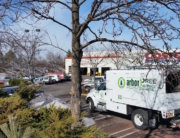We were listening to a story on OPB a few days ago that interviewed a fellow from the National Weather Service in Portland. The outlook is this:
We will be seeing above average temperatures and dry conditions through the rest of summer as well as in to fall and early winter.
This is not the blog post we really want to write, but it’s looking like this heat and drought will be sticking around for a while. The extreme temperatures and dry conditions can place a lot of stress on our trees and stressed out trees are way more susceptible to insect and disease problems.
Yes, trees need water during heat waves and droughts. But it’s a tough call, using water during a drought, so with this, we exercise caution – use water wisely! The City of Bend has some suggestions for water conservation at home and in your yard.
Here are some of our thoughts and tips on caring for trees this summer:
Symptoms of Drought
One of the first signs of drought for deciduous trees is a dulling of the leaves. Advanced symptoms of needing water include yellowing of leaves, wilting and curling at the edges. Leaves may also have a scorched or burned look, turning brown on the outside edges or along the veins.
Evergreen green trees may show signs of yellow, reddish or brown needles. Some fir and other evergreen trees may have branches or tops that turn red or brown. Older trees usually have milder symptoms, so keep a close eye on younger trees.
Watering Tips
When it comes to watering trees, remember this: Water deeper and less frequently, rather than shallow and more frequently. Watering trees for short periods of time encourages shallow rooting, which can lead to more problems down the road.
- Saturate the soil within the drip line—the circle that you could draw around the tree if you traced the tips of the outermost branches.
- Use a soaker hose to water slowly and deeply, so the water doesn’t run off and get wasted elsewhere.
- For conifers, water a few feet beyond the drip line of the tree.
- Water during the coolest part of the day or night for all trees.
- Try to allow for drying in between watering. This allows the water to really soak in and prevents suffocation of the roots.
Try this technique for slow watering. Take a five gallon bucket and put a nail hole in the bottom, near the edge. Fill the bucket with water and leave the slowly leaking bucket under the tree canopy. Do this two or three times per tree, moving the bucket each time.
Additional Tips
- Apply mulch to maintain soil moisture. Apply within the drip line, at a depth of four inches, leaving at least a six-inch space between the mulch and tree trunk.
- Avoid planting annuals or other ground covers under trees to reduce competition for water. Same goes for lawn—if possible remove the lawn under a tree and replace it with a ring of mulch.
- Do not fertilize during dry conditions. Fertilization can require additional water needs.
- Avoid direct damage to trees and roots. This goes for machinery, vehicles, animals or other disturbances.
Having your trees professionally evaluated is always a good idea, especially in severe weather conditions. An ounce of prevention is worth a pound of cure—even when it comes to trees.
Contact us if you have any questions or concerns this summer! 541-480-4223 or shoot us an email.
–Mike D.






